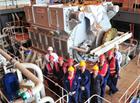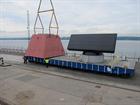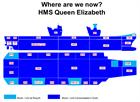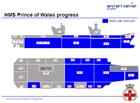Carrier September update
From Ian Booth
Aircraft Carrier Alliance Programme Director
This is an exciting time as we push hard for structural completion of the first ship here in Rosyth. The team is assembling the blocks to form the structure of the ship at a truly impressive rate and in the year since I joined the programme I have seen the ship grow from just Super Block 3 sat alone in the dock to now being virtually a complete carrier. This summer's excellent weather combined with good planning and sheer determinaton has enabled the team to get ahead of schedule so that there are only two sponsons and part of the ramp needed now to reach the structural complete milestone.
But the Carrier team is much more than just the assembly of the first ship in Rosyth. All over the UK, teams are busy putting the finishing touches to the design and are integrating and testing the crucial mission systems and power and propulsion control systems ready for installation and commissioning on the ship. And we shouldn't forget the second ship whose blocks are rapidly taking shape in six different build yard around the UK.
I would commend you to feel as proud as I do of the teams that are driving hard to deliver these superb warships to the Royal Navy.
September 2013 Summary
The last few weeks have seen some remarkable progress in the assembly of HMS Queen Elizabeth, the first of two aircraft carriers being delivered to the Royal Navy.
In fact all the major blocks making up the hull structure are now in place and linked up. Achieving this meant teams could carry out the delicate ‘Drop Stern’ operation. This involved removing all supports from the aft end of the ship. After some careful measurements the supports were carefully removed one by one, allowing the massive structure to settle and flex. Laser measuring devices recorded the stern ‘dropping’ several; centimetres before finally settling into place just as if it were afloat.
With the ‘Drop Stern’ now complete the focus moved on to preparation for the installation of the propeller shafts. The first steps are to confirm the alignment of the structure and to install ‘A’ brackets which will hold and support the shafts in their final position.
Moving from the aft end of the hull to the very top of the forward island, activity is also underway in preparation for the installation of the Long Range Radar. The radar along with the ‘mast cap’ (unit which hold the radar in position on top of the forward island) were shipped from Hengelo in Holland to Rosyth and are set to be lifted into position in October.
Seeing the huge Long Rage radar in place and spinning around will be a great indication of how far this programme has come.
Preparations are also underway to lift the final two sponsons into place at the end of September. The sponsons are the units which protrude from the side of the hull, and when in position, the final two sponsons will complete the flight deck structure.
On HMS Prince of Wales, all the major block sections are now in build, along with several sponson sections. Dates for cutting the first steel on remaining sections are being finalised and the teams are working hard to pull in lessons learned from the first ship.
This month also saw the first propulsion motor fitted to HMS Prince of Wales by teams at Govan.
Head of Ship two, David Shepherd, said: “We’re working hard to make the very most of all the detail we gathered during the construction stages of ship one.”




